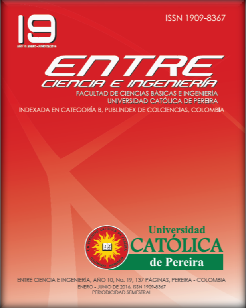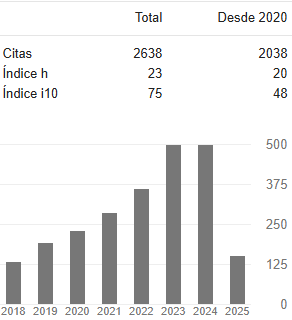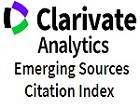Métodos para determinar el factor de intensidad de esfuerzos
DOI:
https://doi.org/10.31908/19098367.483Palabras clave:
factor de intensidad de esfuerzos, mecánica de fractura, métodos analíticos, método de elementos finitos, métodos experimentalesResumen
En este trabajo se presenta una breve revisión de los métodos existentes para determinar el factor de intensidad de esfuerzos. Se presentan algunos aspectos históricos de la mecánica de fractura. Luego se exponen algunos de los métodos clasificándolos en tres grupos: métodos analíticos, de elementos finitos y experimentales. Para cada grupo se presentan algunos métodos, su desarrollo y características principales, incluyendo algunas ventajas, desventajas y restricciones. Se evidencian las razones de la comunidad científica de avanzar en la aplicación de los elementos finitos, debido a su enorme versatilidad, y se aprecia el enorme esfuerzo que implica aprender, dominar y aplicar cualquiera de los métodos.
Descargas
Referencias
R. W. Hertzberg, Deformation and Fracture Mechanics of Engineering Materials. U.S.A.: Jon Wiley & Sons, 1996.
W. Schütz, “A history of fatigue,” Eng. Fracture Mech., vol. 54, pp.263-300, 1996.
L. Parnas, Ö. Bilir, E. Tezcan, “Strain gage methods for measurement of opening mode stress intensity factor,” Eng. Fracture Mech., vol. 55, pp. 485-492, 1996.
T. Fett, Stress Intensity Factors and Weight Functions for Special Crack Problems. Karlsruhe: Forschungszentrum Karlsruhe GmbH, 1998.
M. Aliabadi y D. Rooke, Numerical Fracture Mechanics - Computational Mechanics Publications: Solid Mechanics and its Applications. UK: Kluwer Academic Publishers, 1991.
H. Tada, P. Paris y G. Irwin, The Stress Analysis of Cracks Handbook. 2a edición, St. Louis, Missouri: Paris Productions, Inc., 1985.
Y. Murakami, Stress Intensity Factors Handbook. Oxford: Pergamon Press, 1987.
V. Watwood, Jr., “The finite element method for prediction of crack behaviour,” Nuclear Eng. and Des., vol. 11, pp. 323-332, 1969.
J. R. Dixon y L. P. Pook, “Stress intensity factors calculated generally by the finite element technique,” Nature, vol. 224, pp. 166-167, 1969.
J. Rice y D. Tracey, “Computational fracture mechanics,” en Numerical and Computer Methods in Structural Mechanics, S. Fenves, N. Perrone, A. Robinson y W. Schnobrich, directores, New York: Academic Press, pp. 585-623, 1973.
R. A. Gallagher, “Review of finite element techniques in fracture mechanics,” en Num. Meth. Frac. Mech., Proc. 1st Conf., Swansea: Pineridge Press, pp. 1-25, 1978.
D. Owen y A. Fawkes, Engineering Fracture Mechanics: Numerical Methods and Applications. Swansea, UK: Pineridge Press Ltd., 1983.
S. Atluri, Computational Methods in the Mechanics of Fracture, Vol. 2 de Computational Methods in Mechanics. North-Holland, Amsterdam: Elsevier Science, 1986.
I. Raju y J. Newman, Jr., “Methods for analysis of cracks in threedimensional solids,” J. Aero. Soc. India, vol. 36, pp. 153-172, 1984.
N. Moës, J. Dolbow y T. A. Belytschko, “Finite element method for crack growth without remeshing,” Int. J. for Num. Meth. in Eng., vol. 46, no. 1, pp. 131-150, 1999.
M. Sabsabi, “Modelado de grieta y estimación de vida en fretting fatiga mediante el método de los elementos finitos extendido X-FEM,” tesis doctoral, Dep. Ing. Mec. y Mat., Univ. Pol. Val., Valencia, Esp., 2010.
J. L. Arana, J. J. González, Mecánica de Fractura. España: Servicio Editorial de la Universidad del País Vasco, 2002.
A.A. Griffith, “The phenomena of rupture and flow in solids,” Philos. Trans. Roy. Soc. London, Series A, vol. 221, pp. 163-198, 1921.
E. Orowan, “Fundamentals of brittle behavior of metals,” en Fatigue and Fracture of Metals, New York: Wiley, W.M. Murray. Ed., pp. 139- 167, 1952.
G. Sih, Methods of Analysis and Solutions of Crack Problems, Vol. 1 de Mechanics of Fracture. Leyden, Holanda: Noordho International Publishing, 1973.
D. Rooke, “The development of stress intensity factors,” en Fretting Fatigue, R. Waterhouse y T. Lindley, directores, ESIS 18, Londres: Mechanical Engineering Publications, 1994, pp. 23-58.
D. Broek, Elementary Engineering Fracture Mechanics. The Netherlands: Martinus Nijhoff Publishers, 1984.
T. Fett, Stress Intensity Factors T-Stresses Weight Functions. Karlsruhe: Universitätsverlag Karlsruhe, 2008.
B. Gross, J. E. Srawley, W. F. Brown, Jr, Stress Intensity Factors for a Single-Edge Notch Tension Specimen by Boundary Collocation of a Stress Function. Washington: National Aeronautics and Space Administration, 1964.
B. A. Bilby, A. H. Cottrell, E. Smith y K. H. Swinden, “Plastic yielding from sharp notches,” Proc. Roy. Soc., vol. A 279, pp. 1-9, 1964.
B. A. Bilby y J. D. Eshelby, Dislocations and the Theory of Fracture - Fracture I. Liebowitz: Ed. Academic Press, 1969.
O. L. Bowie, “Analysis of an infinite plate containing radial cracks originating at the boundary of an internal circular hole,” J. Math. and Phys., vol. 25, pp. 60-71, 1956.
O. L. Bowie y D. M. Neal, “Modified mapping-collocation technique for accurate calculation of stress intensity factors,” Int. J. Fract. Mech., vol. 6, pp. 199-206, 1970.
ANSYS, Inc. (2016) USA. ANSYS Simulation driven producto development. [En línea] Disponible: http://www.ansys.com/
Dassault Systemes (2016). Abaqus Unified FEA. [En línea] Disponible: http://www.3ds.com/products-services/simulia/products/ abaqus/, consultado: febrero 2016.
Siemens Product Lifecycle Management Software, Inc. (2016). LMS Samcef Fracture Mechanics. [En línea] Disponible: http://www.plm. automation.siemens.com/en_us/products/lms/samtech/samcef-solversuite/fracture-mechanics.shtml
Cenaero. (2016). Morfeo/Crack: A High-Fidelity Crack Propagation Software. [En línea] Disponible: http://www.cenaero.be/Page.asp? docid=27328&langue =EN, consultado: febrero de 2016.
ESRD, Inc. (2015) Fracture and Damage Tolerance [En línea] Disponible: http://www.esrd.com/Solutions/Fracture.aspx, consultado: febrero de 2016.
G. Kastratovic, A. Grbovic y N. Vidanovic. “Approximate method for stress intensity factors determination in case of multiple site damage,” App. Math. Modelling, vol. 39, pp. 6050-6059, 2015.
E. Giner, N. Sukumar y F. J. Fuenmayor, “An Abaqus implementation of the extended finite element method,” Eng. Fracture Mechanics, vol. 76, pp. 347-368, 2009.
M. Samaei, M. Zehsaz y T. N. Chakherlou. “Experimental and numerical study of fatigue crack growth of aluminum alloy 2024-T3 single lap simple bolted and hybrid (adhesive/bolted) joints,” Eng. Failure Analysis, vol. 59, pp. 253-268, 2016.
S. Pirmohammad y A. Kiani. “Study on fracture behavior of HMA mixtures under mixed mode I/III loading,” Eng. Fracture Mechanics, vol. 153, pp. 80-90, 2016.
P. Weißgraeber, J. Felger, D. Geipel y W. Becker. “Cracks at elliptical holes: stress intensity factor and finite fracture mechanics solution,” Eur. J. Mechanics A/Solids, vol. 55, pp. 192-198, 2016.
M. J. Hammond y S. A. Fawaz. “Stress intensity factors of various size single edge-cracked tension specimens: A review and new solutions,” Eng. Fracture Mechanics, vol. 153, pp. 25-34, 2016.
H. Liebowitz y E. T. Moyer, Jr., “Finite element methods in fracture mechanics,” Comp. & Stru., vol. 31, no. 1, pp. 1-9, 1989.
E. Giner, “Estimación del error de discretización en el cálculo del factor de intensidad de tensiones mediante elementos finitos,” tesis doctoral, Dep. Ing. Mec. y Mat., Univ. Pol. Val., Valencia, España, 2001.
S. Lo y C. Lee, “Solving crack problems by an adaptive refinement procedure,” Eng. Fracture Mech., vol. 43, no. 2, pp. 147-163, 1992.
F. Michavila y L. Gavete “Métodos numéricos para el estudio de singularidades en elasticidad lineal,” en Métodos Numéricos Aplicados a Mecánica de la Fractura, J. Oliver, M. Elices, E. Oñate y M. Astiz, directores, Barcelona: CIMNE, 1988, pp. 1-25.
G. Carey y J. Oden, Finite Elements: A Second Course, Vol. II de The Texas Finite Element Series. NJ: Prentice-Hall, Englewood Cliffs, 1983.
T. Belytschko y T. Black, “Elastic crack growth in finite elements with minimal remeshing,” Int. J. Num. Meth. Eng., vol. 45, no. 5, pp. 601- 620, 1999.
G. Ventura, E. Budyn y T. Belytschko, “Vector level sets for description of propagating cracks in finite elements,” Int. J. Num. Meth. Eng., vol. 58, pp. 1571-1592, 2003.
] E. Giner, N. Sukumar, F. Denia y F. Fuenmayor, “Extended finite element method for fretting fatigue crack propagation,” Int. J. Solid Struc., vol. 45, pp. 5675-5687, 2008.
G. Zi y T. Belytschko, “New crack-tip elements for XFEM and applications to cohesive cracks,” Int. J. Num. Meth. Eng., vol. 57, pp. 2221-2240, 2003.
Afgrow. (2013, Oct.). Methodology For Determining Stress Intensity Factors. [En línea] Disponible: http://www.afgrow.net/applications/ DTDHandbook/pdfs%5CSec11_2_0.pdf> , consultado: octubre 2013.
S. Chan, I. Tuba y W. Wilson, “On the finite element method in linear fracture mechanics,” Eng. Frac. Mech., vol. 2, pp. 1-17, 1970.
S. Pu, M. Hussain y W. Lorensen, “The collapsed cubic isoparametric element as a singular element for crack problems,” Int. J. Num. Meth. Eng., vol. 12, pp.1727-1742, 1978.
S. Ju, “Simulating three-dimensional stress intensity factors by the Entre Ciencia e Ingeniería least-squares method,” Int. J. Num. Meth. Eng., vol. 43, pp. 1437- 1451, 1998.
C. E. Freese y F.I. Baratta, “Single edge-crack stress intensity factor solutions,” Eng. Fracture Mech., vol. 73, pp. 616-625, 2006.
H. Bueckner, “A novel principle for the computation of stress intensity factors,” ZAMM, vol. 50, pp. 529-546, 1970.
J. Rice, “Some remarks on elastic crack-tip stress fields,” Int. J. Solid Struc., vol. 8, pp. 751-758, 1972.
A. Vercher, “Mejora de los elementos de transición en XFEM aplicado a Mecánica de la Fractura Elástica Lineal,” tesis doctoral, Dep. Ing. Mec. y Mat., Univ. Pol. Val., Valencia, España, 2010.
J. Rice, “A path independent integral and the approximate analysis of strain concentration by notches and cracks,” J. Applied Mech., vol. 35, pp. 379-386, 1968.
D. A. Fattori, “Evaluación de la integral J2 y aplicación a problemas en modo mixto 2D de la mecánica de la fractura elástico-lineal,” tesis de maestría, Dep. Ing. Mec. y Mat., Univ. Pol. Val., Valencia, Esp., 2009.
C. Cueto-Felgueroso, “Implantación del método de cálculo de la integral J sobre un dominio,” Anales de Mec. Frac., vol. 18, pp. 388- 394, 2001.
F. Li, C. Shih y A. Needleman, “A comparison of methods for calculating energy release rates,” Eng. Frac. Mech., vol. 21, no. 2, pp. 405-421, 1985.
J. H. Kuang y L.S. Chen, “A single strain gage method for Ki measurement,” Eng. Frac. Mech., vol. 51, pp. 871-878, 1995.
H. Sarangi, K. S. R. K. Murthy y D. Chakraborty, “Optimum strain gage locations for accurate determination of the mixed mode stress intensity factors,” Eng. Fracture Mech., vol. 88, pp. 63-78, 2012.
J. F. Doyle, J. W. Phillips, Manual on Experimental Stress Analysis. Society for Experimental Mechanics, 5th edition
G. A. Papadopoulos, “Study of concentrated vertical load at the apex of a wedge by the experimental methods of caustics and photoelasticity,” Adv. and App. in Mech. Eng. and Tech., vol. 3, pp. 59-81, 2011.
S. Shen, T. Nishioka, “Theoretical development of the method of caustics for intersonically propagating interfacial crack,” Eng. Fracture Mech., vol. 70, pp. 643-655, 2003.
E. E. Gdoutos. “The optical method of caustics,” Optics and Lasers in Engineering, vol. 79, pp. 68–77, 2016.
Descargas
Publicado
Número
Sección
Licencia
Derechos de autor 2019 Entre Ciencia e Ingeniería

Esta obra está bajo una licencia internacional Creative Commons Atribución-NoComercial 4.0.



















